How to Create a Competitive Analysis Report in 5 Steps
Discover how to create a competitive analysis report to understand where your brand sits in the market and identify areas of improvement.

As a marketer, you are always looking for the next big thing to boost your brand’s presence and revenue.
But where do you find this inspiration? Instead of shooting arrows in the dark, what if you could turn to proven strategies?
One way to get this inspiration is by running a competitor analysis. And better yet, combining all the insights and benchmarking metrics into a competitive analysis report, that shows your team the direction to take and how to turn data into strategies.
In this guide, we’ll learn why competitive analysis reports are crucial, how to make one, and the tools you can use to simplify this task. Let’s jump right in.
Key atkeaways
-
What does the process of creating a competitive analysis report tool like? Discover the steps needed to create effective reports- from defining goals, identifying competitors and setting analysis categories to running a SWOT analysis and compiling insights.
-
Understand what manual and automated data gathering implies and what research methods and tools are most effective.
-
Leverage helpful templates to simplify your work like the ones we've created for you.
What is a competitive analysis report?
A competitive analysis report is a document that evaluates your competitors to understand their strengths, weaknesses, strategies, and brand positioning. It shows you their performance and how your brand compares to others in your industry.
It typically contains information on top competitors, their profile, and details like:
- Product/service analysis
- Market positioning
- Marketing and advertising strategies
- Sales strategies
- Pricing strategy
- Customer experience and reviews
- SWOT analysis for each competitor
With this competitor’s activity audit, you get a new lens to look at and build strategies for your business.
Why do you need to create competitive analysis reports?
- Understand market positioning: By researching competitors, brands can see where they stand in the market — who’s leading, who’s lagging, and what differentiates each player.
- Identify strengths and weaknesses: Knowing what competitors do well (and poorly) helps brands refine their own strategies, either by improving on weaknesses or capitalizing on competitor gaps.
- Discover trends and opportunities: Brands can spot industry trends early by monitoring how competitors adapt or innovate, helping them stay relevant and proactive.
- Inform marketing and content strategy: Understanding what content, campaigns, or channels work well for competitors allows brands to adapt or differentiate their own approach.
- Mitigate risks: Competitive analysis reveals potential threats, like new entrants or shifting consumer preferences, so brands can react quickly.
- Support product development: Insights from competitors’ offerings can guide improvements or help avoid costly product missteps.
How to build a competitive analysis report?
Instead of adding metrics to your report randomly, here’s a step-by-step process that will help you build an effective competitive analysis report.
#1. Define goals based on your business objectives
What is your business goal right now? Is it to increase visibility? Or to generate revenue as quickly as possible? This business objective should act as a guide for how to conduct your competitive analysis.
It will also define the type of research you will do (comprehensive or aimed at just a couple of verticals) and the metrics you should focus on.
Let’s take an example to understand this.
Business goal: Increase brand visibility through social media
What to focus on for competitive analysis:
- Identify platforms competitors are most active on (e.g., Instagram, LinkedIn, TikTok).
- Evaluate engagement metrics to see what’s working.
- Study content formats being used (e.g., reels, carousels, stories, lives) and how often they post.
- Analyze tone, voice, and visual branding to understand how they connect with their audience.
- Look at influencer collaborations or user-generated content strategies they’re using.
- Run competitor’s campaigns analysis. Track paid vs. organic efforts to understand whether they boost posts or run full ad campaigns.
The more specific your business goal, the more targeted your competitor’s activity analysis.
#2. Identify the right competitors to analyze
To get the most effective analytics from your competitive market analysis, you need to nail down the right competitors. For instance, in our earlier example of running an analysis focused on social, you need to find those competitors that are targeting social media specifically for visibility.
We generally target three types of competitors for our analysis:
- Direct competitors: Businesses or brands that offer comparable products/services like yours.
- Indirect competitors: Businesses or brands that cater to the same target audience but fulfill their requirements with a different solution.
- Potential competitors: Emerging businesses that aren’t a threat to you right now but are growing at a fast pace to become one in the future.
You can find these competitors using a combination of the following:
- Search for your product or service on Google or social media and look at the top results
- Speak to your sales team and find out the competitor solutions that customers also consider
- Use social listening tools to see what competitors your target audience talks about
- Explore industry forums, Reddit, and niche communities. These are goldmines for organic competitor mentions and real comparisons.
- Use SEO tools like Ahrefs, Semrush, or SimilarWeb to see which websites rank for the same industry keywords.
You should aim for 3-4 competitors to make this analysis of the competitors’ performance detailed without it feeling too overwhelming.
#3. Set the essential competitor information categories to research
Unless you want to focus on just one vertical, you will be analyzing your competitors across different strategies. Instead of haphazardly trying to get these details together, we recommend breaking them down into sections.
Here are some common verticals to include in your competitor’s analytics.
Market positioning and business model analysis
How are your competitors making money? How are they different in the eyes of your shared audience?
That’s where market positioning and business model analysis come in.
Market positioning looks at how a competitor presents itself. For example, are they the ‘premium’ option, the ‘budget-friendly’ choice, or the most ‘effective solution’?
Business model analysis digs into how they make money. Do they have subscriptions, focus on one-time sales, prioritize freemium and convert later, or make money from additional services?
How does this help? Let’s take an example.
If you run a project management tool and a competitor brands themselves as ‘the easiest tool for startups’ with a freemium model, that’s a clear positioning. If another targets enterprises and charges per seat, that’s a different strategy.
Analyzing this helps you find gaps. Maybe no one is targeting mid-sized teams with a simple pricing tier. That’s your opportunity.
Product/service offering comparison
A product/service offering comparison helps you break down what competitors sell, the features they include, and what their customers actually value. Remember, it’s not limited to just listing the features or differences. It’s about understanding why customers choose them over you (or vice versa).
To conduct this, go to your competitor’s website. Look at their homepage. What do they talk about mainly? Next, check their Product/Features section. What are the core features/capabilities they are offering? Are there any features that provide an innovative solution you don’t offer? Note it down as their competitive advantage.
This comparison helps spot gaps in your own offering, opportunities to differentiate, or areas where you might be overdelivering without charging for it. These insights present in your competitor analysis report will shape your roadmap and messaging.
Pricing strategy evaluation
Go through your competitor’s pricing on the website. See what they charge for similar plans or services.
Don’t limit your analysis to seeing who offers the cheapest or most expensive plan. See which competitor is most successful in giving the most perceived value for the price.
You can even find the basis for modifying your pricing strategy if necessary. For example, if you find that you’re charging less than most competitors and still delivering as much value, you can either raise your pricing (within reason) or pivot your marketing messaging to focus on affordability.
For example, look at the copy on Mailmodo’s pricing page.

To make this claim, they needed to ensure they were offering competitive pricing to other brands in their industry.
On the other hand, if your product is priced higher than your competitors', ask yourself: Are you delivering enough value to justify the difference? If the answer is no, you have two options: enhance your offering by adding features, use cases, or better support, or revisit your pricing to better align with customer expectations.
Marketing and messaging assessment
What tone do your competitors often use? How do they position themselves in ads, website copy, or even emails? What pain points are they addressing? Are they making any bold promises?
By studying their marketing materials and messaging, you can refine your own brand voice, align better with your audience, and spot where competitors might be overpromising or underdelivering.
For example, if your positioning matches theirs, you don’t necessarily have to change it. But you do have to back it up better. Imagine multiple budgeting apps claiming to “make saving money simple.”
Instead of changing your message, you could reinforce it by offering a cleaner user interface, more helpful automations, and real customer stories that prove it actually is simple.
You can even understand what kind of tone and messaging resonates well with your audience. Based on these insights, your team can refine the messaging you use to represent your brand.
Digital presence analysis
What online marketing strategies are your competitors using? Are they sticking to blogs? Or they mix it up with events, webinars, referral marketing, and influencer marketing?
You can even see their top traffic sources by using tools like Semrush.
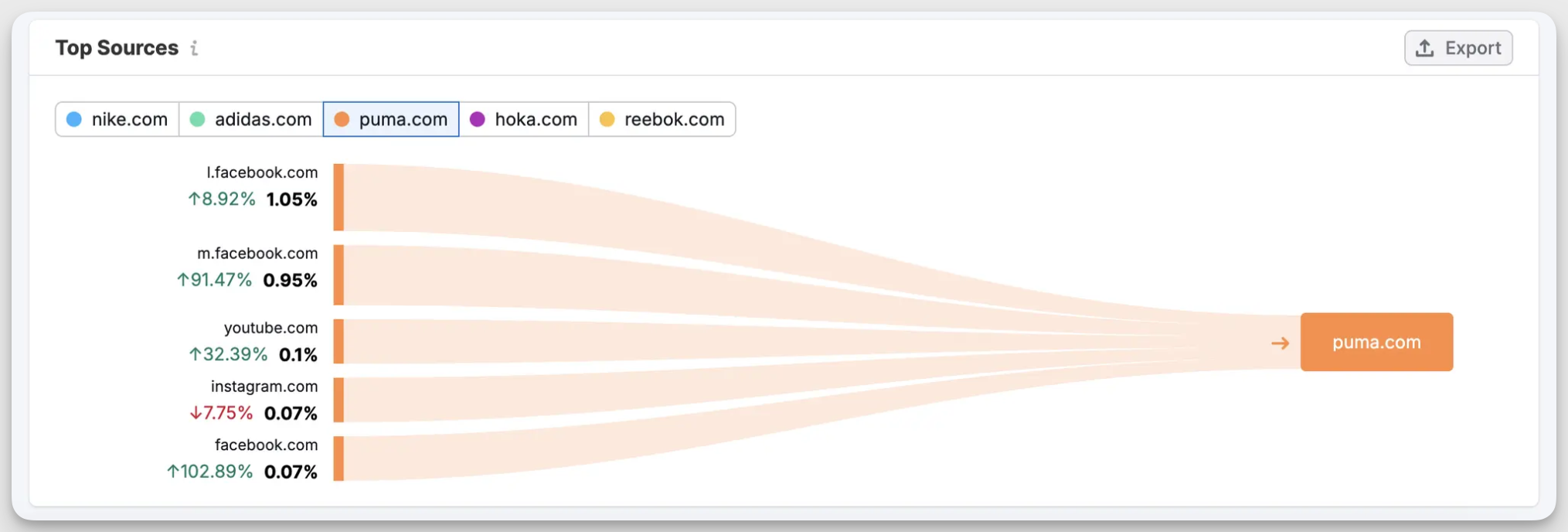
This will show you which channels are performing the best for them. Use these tools to go deeper and understand their content strategies.
For example, we generally use SEO tools to understand our competitors' overall marketing strategy. For each strategy, we look at audience reaction and engagement, channel dominance, frequency of different content formats, and top-performing content pillars.
Based on these insights, our team then identifies gaps we can fill, doubles down on what’s working in our industry, and experiments with new formats or channels that our competitors haven’t explored yet.
Social media performance data and benchmarking
Think about this — approximately 8 out of every 10 U.S. online shoppers use social media to shop. This shows why brands are investing heavily in social media.
But is it enough to just have a presence? Probably not. You’re fighting for attention with other competitors in your niche. Here’s how to compare your performance to competitors on social media and include the insights in your competitor analysis reports.
- Run an audience analysis: This helps you understand who is engaging with your competitors, how many, and how quickly. Start by looking at their follower count and then going deeper.
PS: Tools like Socialinsider can quickly help you with this.
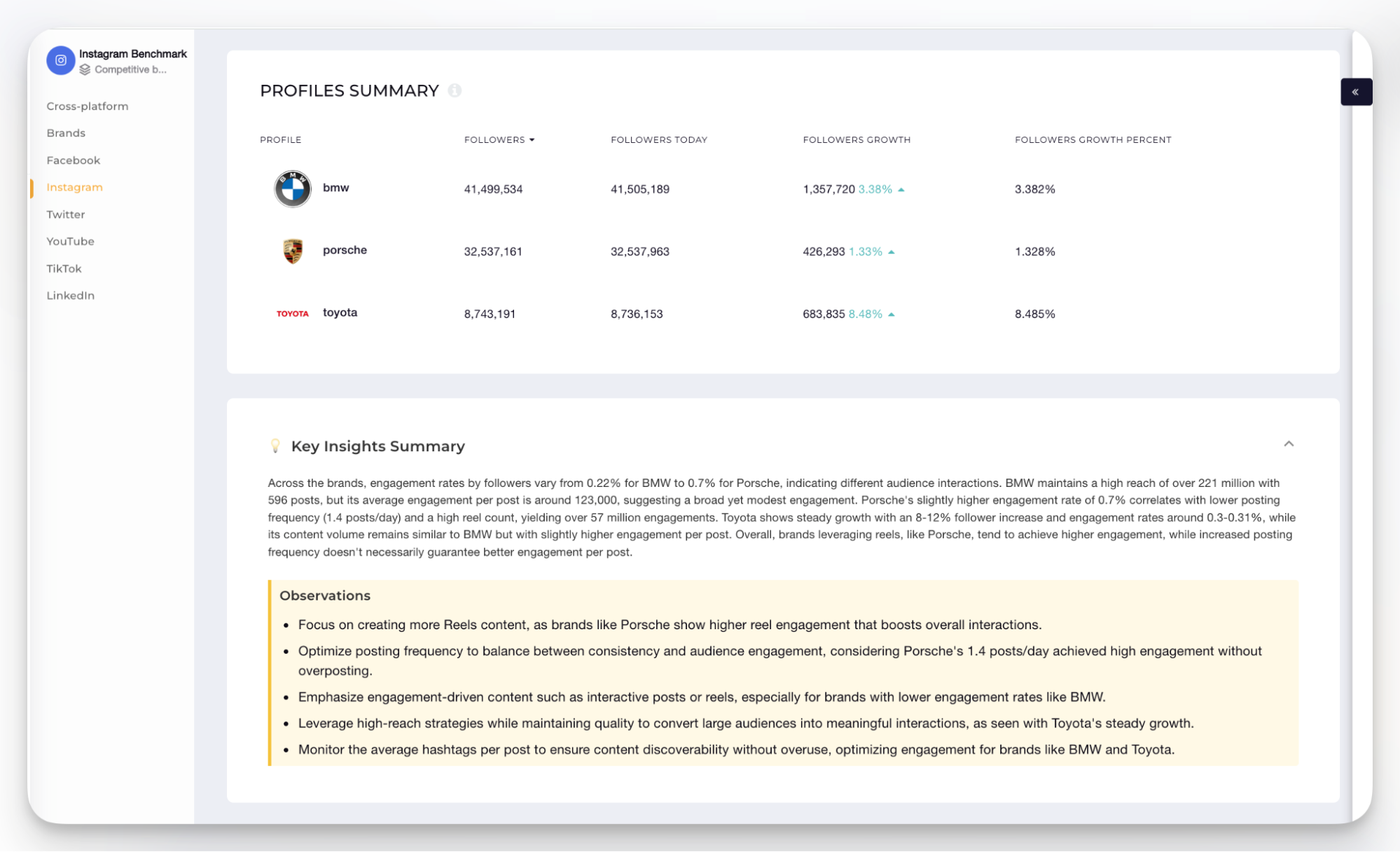
You can then do a micro-level social media audit for each competitor. For example, if your competitor is gaining followers fast on Instagram with majority of Reels content, it could signal the audience’s content preferences.
- Conduct a platform-specific analysis: On a macro level, first see the different channels your competitors are active on. Which channels are they growing fast on? Which platforms is the audience most active on?
You can get this social media data in a few clicks using the competitive benchmarking feature on Socialinsider.
For example, here we see that while Instagram and Facebook has the highest number of followers for BMW, TikTok is quickly growing with an impressive follower growth rate.
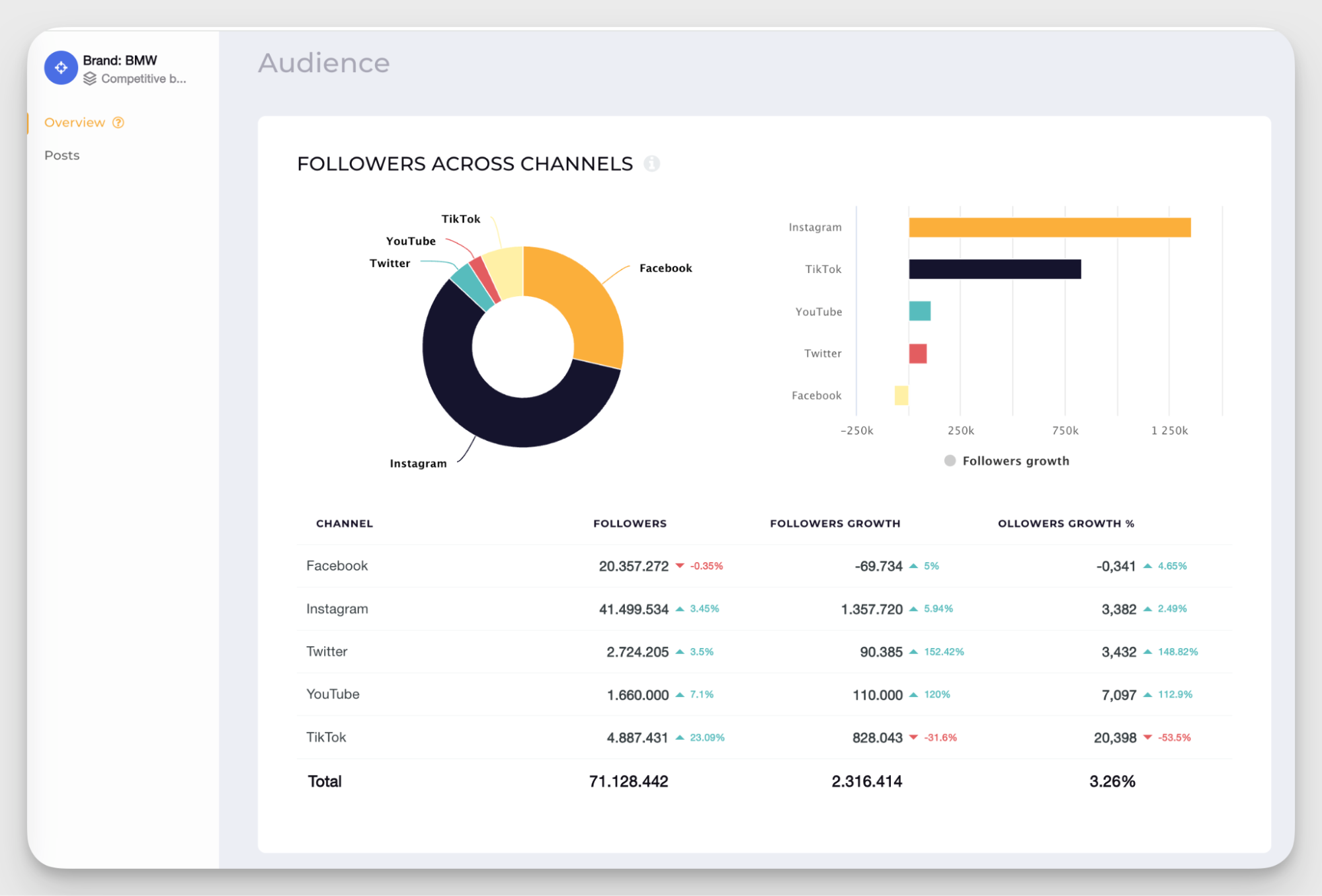
Don’t just stop here. Dig deeper to see platform-specific performance in terms of brand engagement across channels.
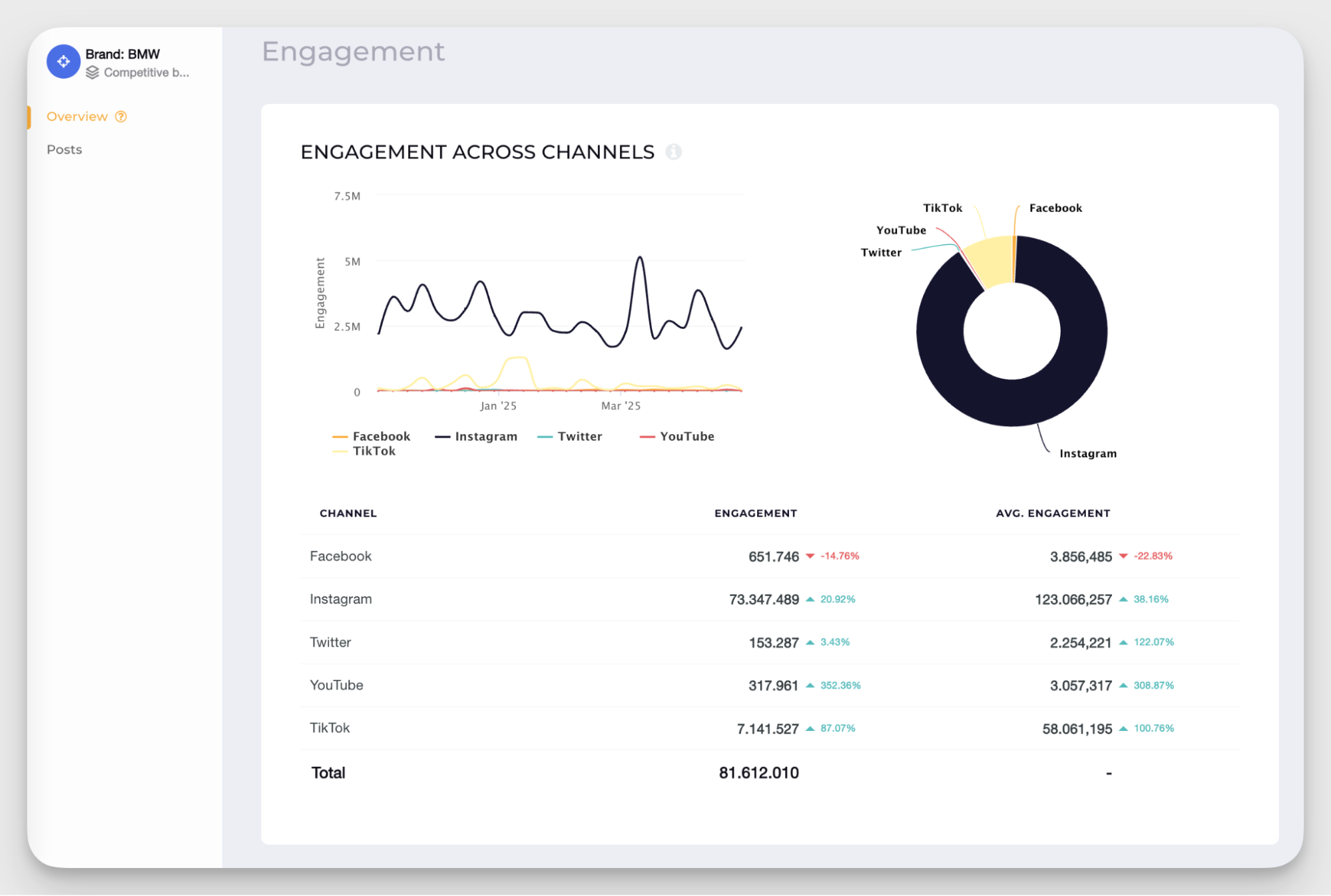
Next, compare competitors' KPIs against your own social media metrics to find gaps and capitalize on them with your channel strategies.
- Compare content performance: Using the benchmarking feature, we also uncovered which are the top content pillars of the brands used as examples so far, and the engagement generated by each of them.

This can reveal what the audience expects or values in your niche. And how is it helpful? It allows you to discover what other relevant topics your brand could join, enabling the opportunity to come up with something fresh and maybe even dominate the space by doing it better.
Once you've done all the steps presented so far, you can go into reviewing each competitor’s best-performing posts to identify patterns in content format (for example, video vs. image), tone of voice, publishing time, or hashtags used.
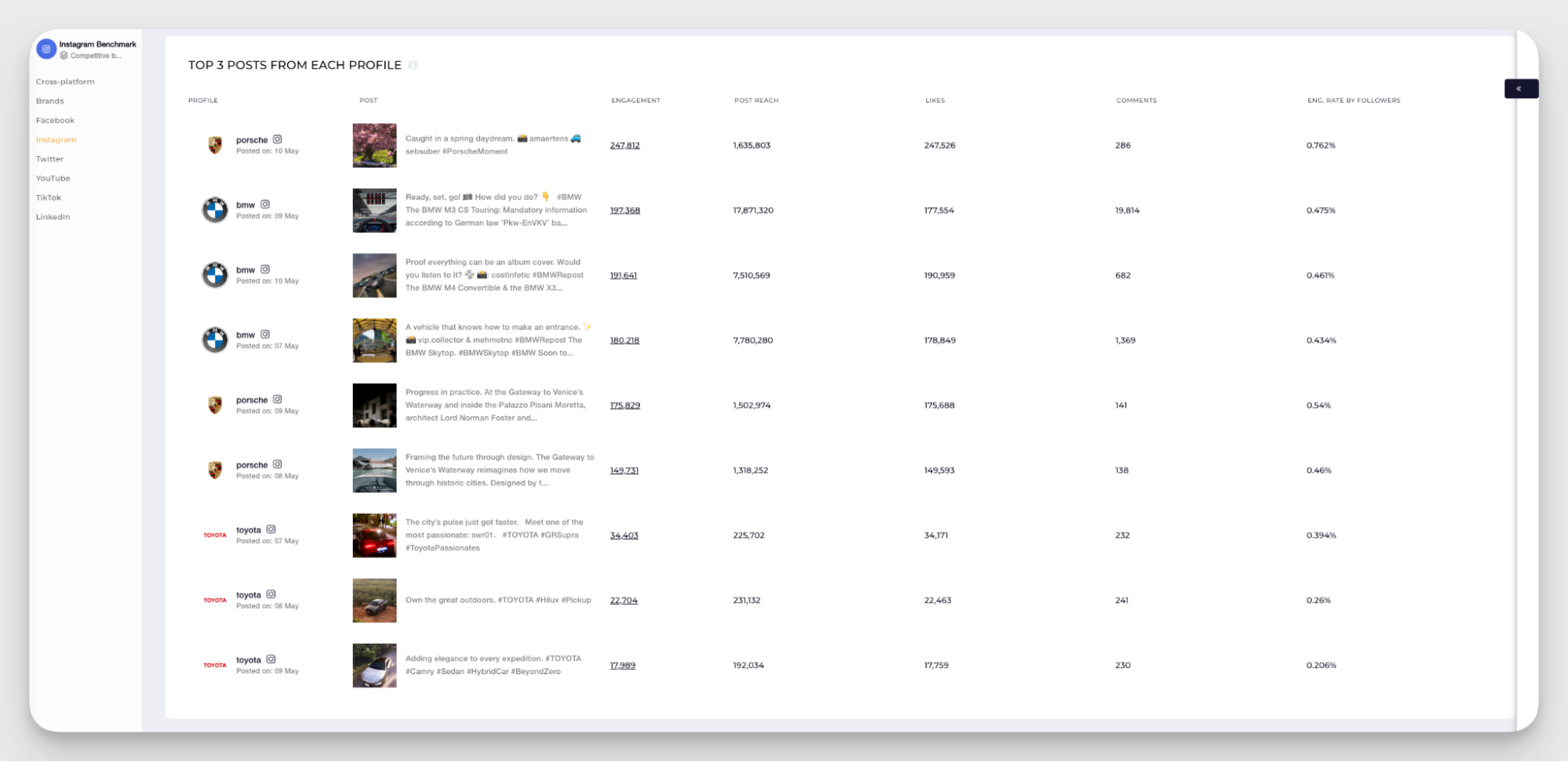
- Benchmark for community management and response rates: People want quick responses on social media. When doing competitor analysis, look at how quickly and consistently your competitors respond to comments, DMs, and mentions. Do they respond only to customer issues or complaints, or do they also reply to every mention in the comments? How do they keep their community engaged?
For example, if a competitor responds within an hour and thanks every commenter, that sets a strong benchmark. By comparing their approach with yours, you can identify areas to improve your engagement and customer experience.
Customer experience and customer satisfaction review
Customer experience can be a big differentiator if most products and services in your industry are similar. By analyzing customer experience and satisfaction, you can see how your competitors are delighting users and where they’re falling short.
Start by reading reviews on platforms like G2, Reddit, or even app stores. Look for patterns. Are customers complaining about clunky onboarding, poor customer service, or missing features? Or are they consistently praising ease of use, quick support, or a specific functionality?
For example, if we look at Asana’s reviews on G2, we can see that most of the recent reviews are positive. This shows that their product and pricing strategies are working well, and it’s a good competitor to learn from. We can even dig further into what their users value the most and use it for our strategies.

You can also analyze social media mentions and customer testimonials on their site to gauge brand sentiment. Are customers loyal, passive, or frustrated?
By comparing customer feedback across your category, you’ll understand how you stack up. More importantly, you’ll find concrete ideas to improve product experience, refine positioning, and win over users who feel underserved by existing solutions.
#4. Run a SWOT analysis
Once you’ve gathered all the competitor data, what’s next? Time to make sense of it with a SWOT analysis.
SWOT stands for Strengths, Weaknesses, Opportunities, and Threats. It helps you turn raw data into clear, strategic insights.
Start by listing your strengths compared to competitors. Maybe your product is easier to use, or your customer support is more responsive. Then list your weaknesses. Perhaps you have fewer features or a smaller online presence.
Next, look at the opportunities in the market. Are competitors ignoring a certain customer segment? Are they slow to adopt new channels like Threads or AI chat? Finally, consider external threats, like a well-funded new entrant or shifting customer expectations.
Instead of simply copying your competitors’ strategies, SWOT analysis forces you to step back and look at the bigger picture. For example, what you’re already doing well, where you’re falling short, and where your biggest opportunities or risks lie based on what others in your space are doing.
#5. Compile actionable insights and recommendations
Imagine you’ve spent weeks researching your competitors. You have data on their pricing, messaging, social media, content, customer reviews, and more.
Keeping the data in a spreadsheet or a slide deck is all bark and no bite. The real value lies in turning competitor insights into clear next steps.
Start by summarizing key takeaways for each core area, like marketing, sales, pricing, product, social media strategy, and customer experience. To make it easier and more actionable, frame your notes around simple, strategic questions like:
- What are our competitors doing better here?
- Where are they falling short?
- What are the gaps we can fill?
- How are we planning to fill these gaps?
- Will we prioritize opportunities by impact or feasibility?
- Can we make an actionable plan for it?
Keep the format of this action plan simple. Use bullet points, short summaries, and clear next steps. Instead of just sharing it with your marketing or product team, we recommend involving all relevant teams. This keeps everyone aligned.
You can share this action plan in your competitor’s research report using a simple spreadsheet or dedicated competitor intelligence tools.
Primary vs. secondary research methods
Should you just rely on competitive benchmarking and studying the competitor’s online presence? Or should you also talk to customers and get feedback from customer-facing teams?
Let’s understand the difference between these research methods and when you should opt for each one.
Primary research method
This consists of first-hand data that you collect directly from sources. The usual methods are:
- Customer interviews: Ask customers what alternatives they considered.
- Surveys and polls: Learn how your audience perceives competitors.
- Product trials: Sign up for a competitor’s product to evaluate UX, onboarding, and service.
- Sales team feedback: Talk to your sales reps about what people are saying about your competitors.
- Focus groups: Explore user preferences and perception of brands in your category.
When to use this method?
- When you want direct insights from real users or your audience.
- To uncover motivations, frustrations, and decision drivers.
Secondary research method
This consists of existing data you gather from public or third-party sources. The usual methods are:
- Website and content audits: Review competitor websites, blogs, and SEO strategies.
- Review sites: See what customers are saying about competitors.
- Social media and ad analysis: Use tools like Socialinsider or Facebook Ad Library.
- News and PR monitoring: Track product launches, partnerships, and market moves.
- Competitive tools: Automate intel gathering using tools like Kompyte or Semrush.
When to use this method?
- When you want to track trends, analyze public strategies, or benchmark performance.
- Best for scaling research across many competitors quickly
Tools that facilitate effective competitive analysis
Do you feel lost in a sea of spreadsheets while running a competitive analysis? Or worse yet, do you spend weeks just gathering data?
Competitive analysis tools can make this process quicker and easier. So you can spend time strategizing instead of working on trivial tasks. Let’s look at the top 4 tools and how to use them.
Kompyte — for monitoring competitors’ website changes, marketing campaigns, and pricing
Kompyte is a powerful tool for monitoring your competitors without manually checking their websites or marketing every day. Here are four key ways this tool can help build a competitor’s performance analysis report.
- Website monitoring: Get alerts when competitors update product pages, pricing, messaging, or new features. This ensures you keep optimizing your product and messaging accordingly.
- Marketing campaign tracking: Monitor their latest blog posts, landing pages, and ad campaigns. See what they’re promoting, how often, and on which platforms. This helps you spot trends, better time your campaigns, and avoid falling behind.
- Pricing alerts: Receive instant notifications when a competitor changes pricing or adds new plans.
- Use competitive insights dashboard: View all competitor moves in one place and share key takeaways with your sales, marketing, and product teams.
Socialinsider — for comprehensive social media analytics and competitive benchmarking
With Socialinsider, you can understand how your brand and competitors perform on social media. You can go beyond basic metrics to get a full picture of what’s working and what’s not.
Here are the four key ways our tool can help out.
- Cross-platform analytics: Track performance across Facebook, Instagram, LinkedIn, TikTok, and more. Monitor engagement, reach, impressions, and follower growth, all in one dashboard.
- Content benchmarking: Compare your content pillars with those of your competitors. See which content topics and formats (images, videos, carousels) drive the most engagement in your industry.
- Top-performing posts: Analyze the most successful posts from competitors to spot trends and opportunities you might be missing.
- Posting patterns: Understand how often competitors post, what times they post, and how it impacts engagement.
Ahrefs — for competitor data on keywords, backlinks, and organic search
Want to know your competitors’ SEO strategies? Ahrefs gives you a complete picture of how they are ranking on Google and why. Let’s explore all that you can do with this tool.
- Perform keyword research and find gaps: See what keywords are bringing traffic to your competitors and spot keywords you’re missing out on. You can even see the keywords they are bidding on for ads.
- Analyze their backlink profile: Discover who’s linking to your competitors’ content. This can help you build your own backlink strategy and even target the same sources.
- See their top pages and get traffic insights: Find your competitors’ highest-performing pages and understand what type of content drives their organic traffic.
- Use their content explorer: Search any topic to see the most shared and linked content in your industry. This is great for planning blog posts or landing pages.
They also offer a lot of additional tools you can use to optimize your SEO strategy.
Typeform — for creating interactive surveys for competitor research
Want to see what customers think about you, and your competitors? Typeform helps build interactive, engaging surveys for your primary research. Here’s how to use this tool:
- Understand buyer choices: Ask customers or prospects which competitors they considered, and why they made their final decision.
- Test perceptions: Use surveys to see how your audience perceives competitor brands in terms of pricing, features, support, or overall reputation.
- Collect feature feedback: Learn which features from competitors your audience values most, and where they feel those competitors fall short.
- Get open-ended insights: Typeform’s clean, conversational format encourages more detailed responses, helping you uncover motivations, pain points, and preferences.
- Send customer exit surveys: Find out why customers are leaving you. Which competitor are they going to? And why.
You can share these surveys via email, social media, or embed them on your site.
Ethical considerations in competitive data gathering
Imagine your team finds a backdoor login to a competitor’s private customer dashboard or scrapes gated content meant only for paid users. It might feel like a clever hack. But it’s not just unethical, it could be illegal.
Here are three ethical considerations you should not overlook:
- Only use publicly available information, such as websites, social media, pricing pages, customer reviews, or tools that gather open data (for example, Ahrefs, Semrush, Socialinsider).
- Buy a competitor’s product to understand the experience, but don’t impersonate a customer or violate their terms of service (like scraping restricted data).
- Avoid soliciting internal information from your competitors’ employees.
Competitive analysis report templates
Instead of starting from scratch, what if you had a template that listed all the key data points you need to gather? It would give you a clear structure, save time, and ensure you don’t miss critical competitive insights.
Here are three templates for you to download and get started with.
Executive summary template
What if you could turn hours of competitor research into a one-page summary your entire team actually reads? That’s exactly what this template will help you do.
Instead of digging through pages of notes, you get a clear snapshot of who your competitors are, what they’re doing well, where they’re falling short, and what you should do next.
Whether you’re planning a campaign, pitching a strategy, or updating your boss, this template keeps everyone on the same page and focused on what really matters.
For example, I’ll fill this template for a competitive analysis we did for BMW.
You can either keep this in a tabular format or use Google Sheets. We've put together the above-exemplified template for you to easily navigate through data and observations
PS: We also recommend using tools like Notion, where you can link pages and sub-pages in case someone wants to see the analysis in detail.
Comprehensive analysis report template
What if you could clearly see how you stack up against your competitors, across every key area of business? A comprehensive competitive analysis report template helps you gather and organize insights on your competitors’ products, pricing, messaging, digital presence, social media, customer sentiment, and more.
Here’s a SWOT analysis downloadable template you can use.
Quick-view competitor dashboard template
Want a quick overview of how your brand stacks up against the competition? This template gives you just that, at a glance. No need to dig through long reports. This template summarizes key insights like product features, pricing, marketing channels, and social media performance side by side for each competitor.
It's perfect for busy teams that need fast, reliable intel to make strategic decisions. Whether you're in a meeting or brainstorming new campaigns, this dashboard helps you spot gaps, strengths, and opportunities in seconds.
Final thoughts
A competitor analysis report uncovers what your competitors are doing, why they are implementing certain strategies, and the gaps you can fill.
This gives your team a clear direction where they can utilize their time and energy. Note that you should keep updating these reports every few months to ensure your business strategies stay relevant. Ready to get started with your competitive analysis?
Use Socialinsider to track your competitor’s social strategy, find content gaps, and analyze performance.
FAQS on competitive analysis report
Who needs a competitive analysis report and what problems does it solve?
Social media managers, brand strategists, product marketers, and even founders rely on competitive analysis reports to stay ahead. These reports solve problems like stagnating engagement, unclear positioning, or underperforming campaigns by showing what competitors are doing differently—and what’s working for them. It’s not just about watching others; it’s about finding your next move with confidence.
What defines an effective competitive analysis report?
A strong report doesn’t just collect data—it connects the dots. It highlights where your brand wins, where it’s falling short, and why. It includes both macro-level benchmarking and platform-specific breakdowns, digs into content performance, and ends with clear, actionable insights. Bonus points if it sparks strategic conversations across teams.
When and how often to conduct competitive analysis reporting?
Quarterly is the sweet spot for most brands, giving you a consistent view of shifts in the market and performance trends. But timing also depends on what you’re planning—before launching a new product, entering a new channel, or testing a new campaign, a fresh competitive snapshot is a must. Think of it as part of your strategic check-in, not just a reporting task.
What are some best practices for creating an insightful competitive analysis report?
A competitive analysis report is only as good as the clarity it offers. To make sure your findings lead to real impact, here are a few best practices to keep in mind:
- Choose the right charts for different metrics: Use line charts to show trends over time—like how engagement or follower growth evolves. For side-by-side comparisons (e.g., brand engagement across platforms), bar charts work best. And when you want to break down shares or ratios, pie charts can help visualize distribution.
- Create effective comparison visualizations: Stacked bar charts, benchmarking tables, and scorecards make it easier to compare performance across competitors at a glance. The goal is clarity—not complexity.
- Adapt to market changes and new competitors: Keep your report dynamic. Regular updates ensure you’re capturing the latest shifts, whether it’s a new player entering the scene or a competitor making bold moves.
What are some common pitfalls when doing competitive analysis and how to avoid them?
Competitive analysis can be a goldmine—but only if done right. Here are a few common mistakes to watch out for:
- Misinterpreting data without context: Numbers don’t mean much on their own. Always look at performance in context—industry benchmarks, campaign timing, audience behavior—all of it matters
- Focusing on the wrong metrics: Not every number tells a useful story. Prioritize metrics that align with your goals.
- Failing to act on competitive insights: Gathering data is just step one. The real value comes when you translate insights into strategy—tweaking your content mix, adjusting your positioning, or exploring new channels.
Analyze your competitors in seconds
Track & analyze your competitors and get top social media metrics and more!
You might also like
Improve your social media strategy with Socialinsider!
Use in-depth data to measure your social accounts’ performance, analyze competitors, and gain insights to improve your strategy.





